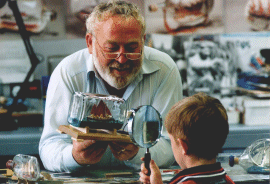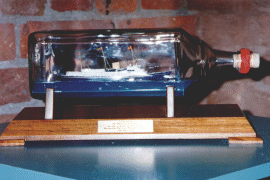"HOW DID YOU COME TO BE PUTTING SHIPS INTO BOTTLES?"
I wouldn't mind
a pound for every time I have been asked this question.
Well, I might as well start at the beginning. I was born in a place called Barrow-in-Furness
on the night of the 10th of May 1941 amid a bombing raid by some fellow with a silly
moustache trying his best to do away with our famous shipyard. Luckily a large shop at the
end of our street managed to shield our house from a direct hit just about the time that I
had decided to make my entrance into the wide and wondrous world.
My father who at the time was dodging bombs while trying to get Mum to an Ambulance was an ex
White Star Line man and my mother, a lovely lady from Liverpool he had fallen in love with
on his many turn-arounds in that port. I had an Uncle Jim, my Mum's brother, who was also
at sea although I can't remember which company he was with. But I remember him telling me
as a boy how he watched the German pocket battleship Graf Spee in Montevideo harbour. I also
had a brother who was in coasters for James Fisher & Sons of Barrow, so I think we can
assume that there was some sea swishing around in my blood somewhere.
As a boy I grew up with ships and boats all around me. There was a boom in the shipbuilding
industry and the docks were always full of ships from all over the world bringing in iron
ore, jute, wood pulp and many other exotic things. When I was not at school or watching
ships my father would have me with him down at the beach helping with his three small
vessels that he used for sailing or fishing.
In those days pocket-money was just something I had heard posh kids talk of so a real toy
boat was something I could only watch the others play with. At school kids were always
swapping things and I managed to obtain broken toy boats this way, which with the help of a
little imagination and a modified saw blade which substituted for a penknife, I would
create my little fleet which I could tow around the boat pond with a piece of string
pinched from one of my dad's fishing lines. By the time I had reached my teens I had become
quite handy with my hands and shown this in my work at school in art, woodwork, practical
drawing etc, and I thought then that when I left school I might be able to find something
I could do at sea and thus achieve my ambition. Alas this was not to be and despite my
father's approval for my brother to go to sea he would not sign any papers to allow me to
follow in the footsteps - or should I say wellies - of either my brother or himself.
Time went on and in that time I worked on all types of ships, liners, tankers, gas
carriers, destroyers, frigates, aircraft-carriers and, of course atomic submarines. While
working on these vessels I would from time to time pick up a nice piece of wood and shape
it into a model boat giving it to one of the men to give to their children.
One of the snags of being small was that there was always a bully who wanted to pick on the
small fellows and one day he picked on me in front of the work-force.
He had decided to try and belittle with a challenge. "You think you can make model boats but
I bet you can't get one inside this light bulb."
I had heard talk of masts folding and string being used to pull them back into place, so I
thought: here goes then, in for a penny in for a pound.
After a couple of days the moment of truth had arrived and all were assembled in the
welding store - a bit like "High Noon" I thought. With bated breath and silence all around
me I placed this very crude and flimsy vessel through the neck of the bulb gently placing it
into its sea of plasticene. Now, the moment of truth was truly here. Will it work or won't
it? That is the question. Gently I pulled on the thread - very slowly at first - then
everything started to come back together as if by magic. I'd done it! I had actually done
it! The bully paid out his hard earned cash and I made quite a few new friends from the
gambling fraternity that day.
Eventually I left Barrow-in-Furness for the bright lights of Show Business following some
success in a National Talent Contest. This took me all over the country singing in clubs
till one day a Liverpool agent I was working for asked me to make Liverpool my base, so I
came to settle in Liverpool.
My enthusiasm for ships and the sea was still in me and I enjoyed listening to the old
salts telling me their yarns and, of course the inimitable Liverpool humour that went with
them.
It was during this time that I took up my old hobby of building and sailing model boats and
I joined the Crosby Model Club. I enjoyed being in a model club again and as I was at
a
loose end during the day I became the 'Pro' for the club.
In 1978, there was an appeal for anyone who could make any kind of contribution to a
proposed new maritime museum at Liverpool. I volunteered to arrange model boat displays and
demonstrations of model shipbuilding. This went down very well with the visitors to the then
small museum and one day in the summer of 1983 I thought; What can I put on show that I
have never exhibited before? The only thing that I hadn't shown was a ship in a gallon
bottle. By coincidence the Curator of the Museum, Mike Stammers, happened to come down this
day and on spotting the model ship in the bottle asked me whose it was. "Mine" I said.
"Where did you get it?" said Mike. I made it," I replied. Mike's face beamed as he said:
"I've been looking all over for someone who does this."
Mike told me of the plans for 1984
and the Tall Ships Gallery whose opening was to coincide with the visit of the Tall Ships
that year. One of the exhibitions was a collection of ships in bottles loaned by 'Jo' Dashwood-Howard and Mike thought it would be a good idea to complement it by including some actual
ship bottling demonstrations on the spot. I agreed to come along on Saturdays and Sundays
for a couple of hours to do this.
This idea of Mike's proved to be a good one. It received much publicity and interest from
the media - so much so that I was asked to join the crew on the Staff at the museum as the
official "Ship in Bottle Demonstrator". Since that day I have had good fortune to make
friends, appear on several television shows and to talk on numerous radio programmes and to
represent the Museum at many trade shows in Britain, Paris and Brest. The ultimate test
came when I as asked to make special presentation models for H.R.H. The Duke of Kent,
H.R.H. The Prince of Wales and Her Majesty The Queen to mark their visits to the Museum.
Each of these models was a real challenge and naturally I had to try my best.
The model
selected for Prince Charles was of the first Royal Yacht "Mary" which was the ship given to
Charles II by the people of Holland and from which we have artefacts on display at the
Museum.
The Prince seemed to have been very pleased with his unusual gift which I had the privilege of delivering personally to him at a later date.
Next was the Duke of Kent. He was having a tour of the Museum and as he is the Royal Patron
of the R.N.L.I. his model was of the New Brighton Lifeboat of 1897 the "Queen" a vessel
named after his great-grandmother Queen Victoria. Again a great appreciation was shown and
we had a good chat later on the unique history behind the model. On this occasion he
insisted on taking the model away with him.
After the presentation, I was introduced to Her Majesty
who was very curious to how I had achieved the getting of the model of her yacht into a
bottle. I gave a demonstration of techniques I had used and again we seemed to have another
satisfied Royal.
It was assumed that I would again be expected to deliver the model to London but about two
hours later a phone call came through from the Royal Yacht, which was at the Pier Head
at the time.
Yes, when people say: "How did you come to be putting ships in bottles?" a lot of memories
flood through my mind and I can remember, when my wife and I were being put up in a luxury
hotel in London by a television company, thinking to myself. What would that bully think if
he could see what he had caused.
Des Newton was awarded in 1989 the "Lifeboatman" statuette for his services to the R.N.L.I.
Both Des and Mrs Newton were made Life Governors of the R.N.L.I. for their joint services
and represented the Institution at the Queen's Garden Party.
















Return to Home Page
This List was last updated on 1st March 2004.
The number of people who have looked
at this page so far is:
Design by
